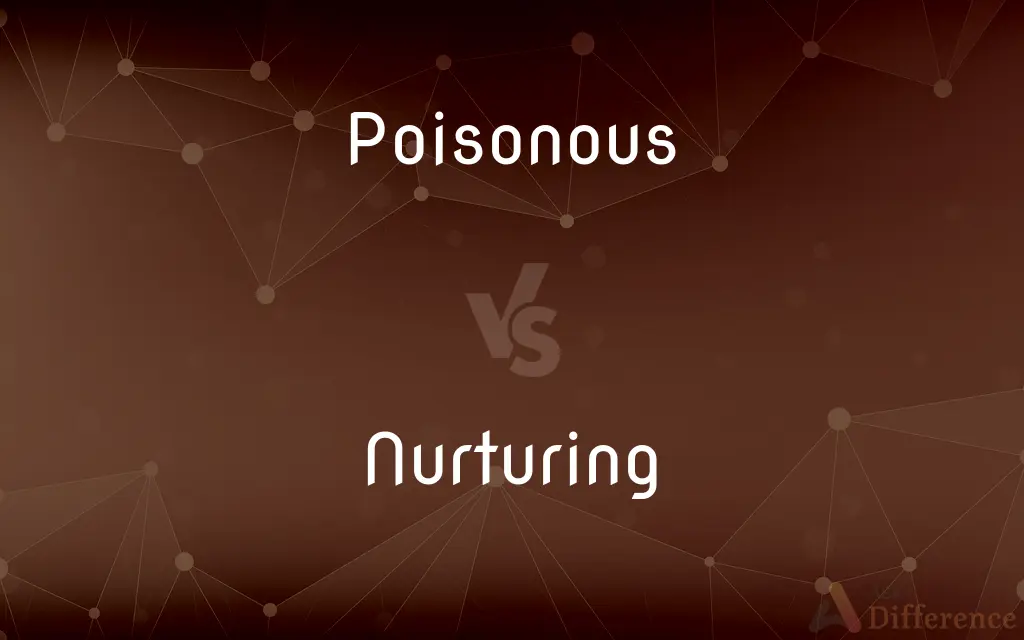Poisonous vs. Nurturing — What's the Difference?
By Maham Liaqat & Urooj Arif — Updated on March 12, 2024
Poisonous refers to substances or environments harmful and potentially fatal to life, while nurturing involves care, support, and encouragement conducive to growth and development.

Difference Between Poisonous and Nurturing
Table of Contents
ADVERTISEMENT
Key Differences
Poisonous substances or environments carry the potential to cause harm or death when ingested, inhaled, or absorbed. This term often relates to chemical, biological, or even social elements that can lead to detrimental health effects, disrupting physiological functions or mental well-being. On the other hand, nurturing refers to the act of providing care, support, and encouragement that fosters growth and development. It can apply to various contexts, including parenting, education, relationships, and even environmental stewardship.
The contrast between poisonous and nurturing is stark, representing the spectrum of influences that can impact living organisms. While poisonous elements introduce risk and potential harm, nurturing elements contribute to health, growth, and positive development. Understanding the difference is crucial in various domains, from healthcare and environmental conservation to education and social work, guiding actions and decisions that affect the well-being of individuals and communities.
Recognizing and mitigating poisonous influences—whether they are substances, behaviors, or societal dynamics—is essential for safeguarding health and promoting a nurturing environment. Conversely, identifying and fostering nurturing conditions can enhance quality of life, support development, and build resilience, highlighting the importance of these concepts across multiple facets of life and society.
Comparison Chart
Definition
Harmful and potentially fatal to life.
Providing care, support, and encouragement for growth.
Contexts
Chemical, biological, environmental, social.
Parenting, education, relationships, environmental stewardship.
ADVERTISEMENT
Effects
Detrimental to health, causing illness or death.
Promotes well-being, growth, and positive development.
Examples
Toxic plants, venomous animals, harmful substances.
Supportive parenting, effective teaching, healthy ecosystems.
Goal
Recognition and avoidance to prevent harm.
Creation and maintenance to foster development and well-being.
Compare with Definitions
Poisonous
Capable of causing harm through chemical action.
The poisonous berries caused severe illness in those who ingested them.
Nurturing
Providing emotional support and encouragement.
Her nurturing guidance helped the students develop confidence.
Poisonous
Detrimental to mental or emotional health.
The poisonous work environment led to high levels of stress and burnout.
Nurturing
Creating a supportive educational setting.
The teacher's nurturing approach fostered a love of learning.
Poisonous
Harmful to ecosystems or environments.
Poisonous industrial waste polluted the river, harming aquatic life.
Nurturing
Encouraging positive relationships and communities.
The community center provided a nurturing space for local youth.
Poisonous
Toxic substances or organisms.
The gardener avoided planting poisonous plants to ensure the garden was safe for children.
Nurturing
Fostering growth and development in children.
The nurturing home environment contributed to the child's well-being.
Poisonous
Requiring caution and protective measures.
Handling poisonous chemicals requires specialized safety equipment.
Nurturing
Promoting environmental conservation and health.
Nurturing the garden with organic practices supported biodiversity.
Poisonous
Containing or being a poison
Poisonous fumes.
Nurturing
The action of raising or caring for offspring
The nurture of an infant.
Poisonous
Capable of harming or killing by poison
Poisonous tentacles.
Nurturing
(Biology) The sum of environmental influences and conditions acting on an organism, especially in contrast to heredity.
Poisonous
Full of ill will; malicious or spiteful
A poisonous look.
Nurturing
The fostering or overseeing of the development of something
The nurture of an idea.
Poisonous
Harmful or destructive
A poisonous precedent.
Nurturing
Something that nourishes; sustenance
"The butterfly poked its tiny proboscis down into her hair, probing for nurture" (Barbara Kingsolver).
Poisonous
Containing sufficient poison to be dangerous to touch or ingest.
While highly poisonous to dogs, this substance is completely harmless if ingested by humans.
Nurturing
To raise or educate (a child, for example).
Poisonous
(figuratively) Negative, harmful.
Nurturing
To encourage or help develop; cultivate
"a small college town that had nurtured his intellectual and creative pursuits" (James S. Hirsch).
Poisonous
Having the qualities or effects of poison; venomous; baneful; corrupting; noxious.
Nurturing
To provide sustenance for; nourish
The meadow that nurtures the cattle.
Poisonous
Having the qualities or effects of a poison
Nurturing
Present participle of nurture
Poisonous
Not safe to eat
Poisonous
Marked by deep ill will; deliberately harmful;
A malevolent lie
Poisonous hate...in his eyes
Venomous criticism
Vicious gossip
Common Curiosities
Can a person be both poisonous and nurturing?
While individuals can exhibit behaviors that may be harmful or supportive at different times, consistently exhibiting both poisonous and nurturing behaviors in the same context is contradictory and rare.
What are common signs of a poisonous plant?
Common signs can include bitter or soapy tastes, milky sap, umbrella-shaped flowers, or certain color berries, but these are not definitive; proper knowledge or expert advice is essential.
How can an environment be nurturing?
An environment is nurturing when it provides the conditions and support necessary for the growth, development, and well-being of living organisms, including emotional, intellectual, and physical aspects.
What are the challenges of identifying poisonous substances in the environment?
Challenges include the vast number of potential toxins, varying effects on different organisms, and the presence of substances in unexpected places.
What measures can be taken to mitigate poisonous risks?
Measures include education about poisonous substances and environments, using protective equipment, following safety protocols, and avoiding known hazards.
How can communities become more nurturing?
Communities can become more nurturing by fostering inclusivity, support networks, access to resources, and opportunities for positive engagement and growth.
What role does nurturing play in environmental conservation?
Nurturing plays a crucial role in environmental conservation by promoting practices that sustain and regenerate natural ecosystems, supporting biodiversity and ecological health.
How does nurturing affect child development?
Nurturing affects child development by providing the emotional support, security, and stimulation needed for physical, cognitive, emotional, and social growth.
Why is a nurturing approach important in education?
A nurturing approach in education is important because it supports students' emotional and intellectual development, encouraging engagement, creativity, and resilience.
How does nurturing contribute to societal well-being?
Nurturing contributes to societal well-being by promoting healthy, supportive relationships and communities, fostering development, resilience, and a positive social fabric.
What are the long-term effects of exposure to poisonous substances?
Long-term effects can include chronic health conditions, irreversible damage to organs, and in severe cases, shortened lifespan or fatal outcomes.
How can nurturing relationships impact mental health?
Nurturing relationships can have a profound positive impact on mental health, providing emotional support, reducing stress, and fostering a sense of belonging and security.
Can a workplace be poisonous?
Yes, a workplace can be considered poisonous if it promotes harmful behaviors, stress, burnout, or undermines the health and well-being of its employees.
How can one develop a nurturing mindset?
Developing a nurturing mindset involves empathy, compassion, commitment to supporting others, and actively seeking to provide environments that foster growth and well-being.
Share Your Discovery

Previous Comparison
Sneak vs. Creep
Next Comparison
Ask vs. WonderAuthor Spotlight
Written by
Maham LiaqatCo-written by
Urooj ArifUrooj is a skilled content writer at Ask Difference, known for her exceptional ability to simplify complex topics into engaging and informative content. With a passion for research and a flair for clear, concise writing, she consistently delivers articles that resonate with our diverse audience.














































